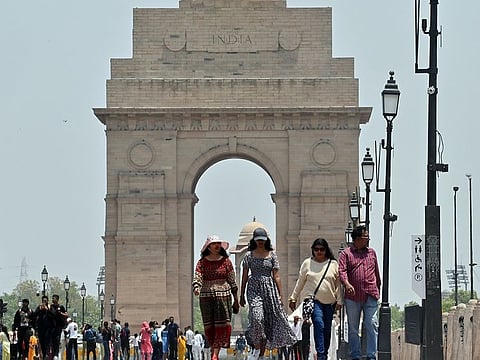Why is India experiencing such extreme temperatures?
The heat wave is truly on as North India crosses 52 degrees celsius in Delhi

The straggling seven-phase Indian election has entered the home run, but it is going to extract every last ounce from the Indian voter. Delhi is among several North Indian states where votes have been cast amid a brutal heatwave.
The Meteorological Department has issued a red alert as places in the national capital inch within touching distance of the mind-boggling 52 degrees Celsius. While the intensity is unusual and paralysing, a stifling Indian summer is by the playbook.
The alert extends to Rajasthan, Punjab, Haryana, Chandigarh, Delhi, and west Uttar Pradesh where daytime temperature in at least one town has breached the big 50 degree psychological mark. The variations in weather patterns right before our eyes are classic climate change traits, including the lack of quick relief. In the past, a heatwave lasted barely a week at a go, but the present forecast warns of a much longer stretch.
Public response to extreme weather conditions is not linear, it cannot be. In India, as warnings to stay indoors escalate and schools are closed, daily wage labourers, construction workers, and the unorganised workforce who have no option but to stay out in the scorching sun face the brunt of the heat.
No longer a question mark
But how many Indian families own air-conditioners or for that matter is a cooling facility much like air purifiers even an option in rural or government schools? That superstar Shah Rukh Khan was hospitalised for heatstroke during IPL — fortunately, the cricket league has concluded — should tell us how vulnerable the exposed low-income groups are.
It is not just extreme climate but also prolonged conditions as seen in the current heatwave in India that indicate the new climate change normal. A report by US-based Climate Central predicts that the impact of global warming in the country will also be felt in the increase in night-time temperatures making the situation further alarming. The report adds that ‘human-caused climate change has made this intense heat much more likely.’
From unseasonal floods in Delhi, Uttarakhand, and Kashmir in recent years to unprecedented temperatures, India’s location makes it among the most vulnerable to global warming. However, the global threat has also been felt in far-flung nations even before the year’s halfway mark.
From floods in Brazil, landslides in Papua New Guinea, torrential rain in the UAE to Mexico’s heatwave causing power blackouts and water crisis, the unheard is no longer a question mark. ‘This is the watermark of climate change,’ says a report by the Centre for Science and Environment. ‘It is not about the single event but about the increased frequency of the events- an extreme event we saw once every 100 years has now begun to occur every five years or less.’
Also Read: Fatal consequences of toxic work culture
Frequency of natural disasters
India had the opportunity, in this agenda-less election, climate change would have been a noteworthy order of business. Instead, In the heat and the hate of the campaign trail when tangibles like jobs and inflation didn’t get a look in from the ruling BJP, what hope was there for a discourse on climate change or air quality?
Electoral politics is about bijli and paani (electricity and water), it is, however, an age-old discourse that is in isolation and unconnected to the emerging environmental reality.
Yet, its destruction can be quantified. For instance, floods in Assam two years ago led to 4.7 million people displaced and damage that was estimated to be approximately rupees 10,000 crore. It is not just economic loss; resources are also pushed in for rehabilitation.
With agriculture stress and global warming inexorably linked, the increased frequency of natural disasters including droughts has an almost immediate impact on the agrarian sector including crops, malnutrition, and livestock. Storage of fresh produce in these soaring temperatures becomes challenging and India’s food losses annually are in no small numbers.
Environment and sustainability
A Lancet report says extreme heat has led to a 55% rise in deaths in India between 2017-2021. Between 2015-2022, almost four thousand people died of rising temperatures.
The loss of income caused by heatwaves reports the Lancet, equals 5.4% of India’s GDP, and already hospitals are reporting an increase in the number of patients. But the enormity has still not hit the country. Climate activist Sonam Wangchuk’s recent 21-day fast for safeguards for Ladakh’s ecology was by and large ignored by the Indian media.
Strengthening health care at the local level, cold chain infrastructure, and taking anti-pollution steps throughout the year, not just seasonally are solutions that cannot be ignored. Environment and sustainability may not sound glamorous, but this is the urgent policy intervention and investment India needs.
The fight for climate change is collective and yet as India has been witnessing from floods to heat, it is also each for their own. The voter is facing the heat for now, but the mayhem is just beginning.
Sign up for the Daily Briefing
Get the latest news and updates straight to your inbox




